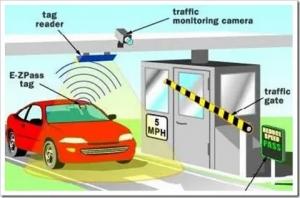Electronic Toll Collection Market Set to Hit USD 43.89 Billion by 2035 Amid Surge in Smart Mobility Infrastructure
Global electronic toll collection market is growing rapidly, driven by rising demand for smart transportation systems & seamless toll collection technologies
The development of next-generation toll collection technologies is driving the market forward, as they incorporate innovations such as multi-lane free flow (MLFF) systems, vehicle-to-infrastructure (V2I) communication, and enhanced connectivity with smart city infrastructure. These advancements offer more efficient, user-friendly solutions that meet the needs of modern transportation systems. Additionally, the integration of data analytics, artificial intelligence (AI), and cloud-based technologies in tolling operations allows for real-time traffic management, accurate fee calculation, and improved customer experience. As tolling infrastructure expands in emerging economies, the ETC market is witnessing increasing opportunities for global players to enter untapped markets, especially in regions like Asia-Pacific, where rapid urbanization and infrastructural growth are pushing the demand for efficient road management solutions.
Get Ahead with Our Report: Request Your Sample Now!
https://www.futuremarketinsights.com/reports/sample/rep-gb-76
Key Takeaways for the Electronic Toll Collection Market
The electronic toll collection (ETC) market is experiencing significant growth driven by technological advancements and the need for efficient transportation infrastructure. The market is expected to expand steadily, reflecting a robust CAGR of 10.6%, as tolling systems evolve from traditional manual methods to automated, contactless solutions. ETC systems are revolutionizing road tolling and traffic management, with smart city initiatives and government regulations further fueling adoption. The integration of data-driven technologies such as AI and machine learning is enabling more effective traffic management and enhancing the accuracy of toll payments, benefiting both consumers and transportation authorities.
Emerging Trends in the Global Market
The ETC market is evolving with several emerging trends that are shaping the future of transportation and tolling systems. One of the most notable trends is the increasing shift toward multi-lane free flow (MLFF) systems, which allow vehicles to pass through tolling points without stopping, reducing congestion and improving travel time. This technology is becoming increasingly popular as toll operators aim to enhance customer satisfaction by eliminating delays and streamlining the payment process. Additionally, the incorporation of vehicle-to-infrastructure (V2I) communication is enabling more seamless integration between vehicles and tolling infrastructure, facilitating the exchange of real-time data and improving the efficiency of toll collection.
Another key trend is the rise of contactless and mobile payment options. As consumers demand more convenient and secure payment methods, toll operators are integrating mobile wallets, RFID (Radio Frequency Identification) tags, and digital currencies into tolling systems. This shift is making toll payments more accessible, especially in regions where credit card penetration is low. Furthermore, the advent of data analytics and AI in traffic management is allowing for smarter decision-making, as these technologies enable toll authorities to analyze traffic patterns, optimize toll prices dynamically, and predict congestion points in real time.
Significant Developments in the Global Sector: Trends and Opportunities in the Market
The global electronic toll collection market is witnessing several significant developments that are shaping its future growth trajectory. One of the key factors contributing to this growth is the ongoing investment by governments and transportation agencies in infrastructure modernization. Countries worldwide are prioritizing the development of smart transportation systems and intelligent road networks to improve road safety and reduce congestion. The increasing adoption of smart city initiatives, which integrate tolling systems with broader urban management solutions, is creating new opportunities for market players to expand their presence in the sector.
In particular, emerging economies in Asia-Pacific, Latin America, and Africa are witnessing rapid growth in road infrastructure development, creating substantial demand for automated tolling systems. As these regions focus on modernizing their transportation networks, they are adopting advanced ETC solutions to optimize traffic flow and generate more sustainable revenue streams. Additionally, the growing popularity of electric vehicles (EVs) is expected to influence the ETC market, as new tolling systems must accommodate EVs, which often have different charging needs and toll rates compared to traditional vehicles. This trend is pushing companies to develop more flexible and adaptable tolling technologies.
Recent Developments in the Market
Recent developments in the ETC market reflect the broader shift towards digital and contactless technologies in the transportation sector. Several companies are collaborating with government agencies to deploy state-of-the-art tolling systems that enable more efficient traffic management and payment processing. Key players in the market are increasingly integrating AI-driven solutions into their tolling systems, providing enhanced accuracy in toll collection and enabling real-time data analytics for better decision-making. The rise of smart city initiatives is also spurring growth in ETC adoption, with several cities around the world implementing integrated tolling systems that work seamlessly with traffic management, parking, and public transportation networks.
Moreover, the COVID-19 pandemic has accelerated the adoption of contactless payment technologies, with many regions accelerating the rollout of ETC systems to reduce physical interactions and enhance public health safety. This trend is expected to continue as the demand for touchless, efficient, and frictionless payment systems remains high.
Detailed Market Study: Full Report and Analysis
https://www.futuremarketinsights.com/reports/global-electronic-toll-collection-market
Competition Outlook
The electronic toll collection market is highly competitive, with numerous global and regional players offering a wide range of solutions for various applications. Leading companies are focusing on technological innovation, including the development of MLFF systems, advanced V2I communication, and integration with smart city technologies to maintain their competitive edge. Strategic partnerships, acquisitions, and collaborations are common as companies seek to expand their portfolios and strengthen their market presence.
Key Market Players
Key players in the ETC market include TransCore, Kapsch TrafficCom AG, Thales Group, Siemens AG, Cubic Corporation, and Conduent Inc. These companies are actively involved in the development of next-generation tolling systems, including RFID-based solutions, mobile payment integration, and AI-powered traffic management systems. The competition is expected to intensify as new players enter the market and demand for efficient, automated tolling solutions continues to rise globally.
Key Segmentations
Key market segments include technology (RFID, DSRC, GNSS, and video tolling), application (highway tolling, urban tolling, and parking), and end-users (government, private operators, and tolling agencies). Geographically, North America and Europe are currently leading the ETC market, while Asia-Pacific is expected to witness the highest growth rate due to rapid infrastructure development and smart city projects.
Vertical Solution Industry Analysis Reports
Smart Electric Meter Market Outlook 2025 to 2035
https://www.futuremarketinsights.com/reports/smart-electric-meter-market
Assisted Living Software Market Outlook 2025 to 2035
https://www.futuremarketinsights.com/reports/assisted-living-software-market
Marketing Transcription Market Outlook 2025 to 2035
https://www.futuremarketinsights.com/reports/marketing-transcription-market
Customer Experience Platforms Market Outlook 2025 to 2035
https://www.futuremarketinsights.com/reports/customer-experience-platforms-market
Customer Analytics in E-commerce Market Outlook from 2025 to 2035
https://www.futuremarketinsights.com/reports/customer-analytics-in-ecommerce-market
Ankush Nikam
Future Market Insights, Inc.
+ +91 90966 84197
email us here
Visit us on social media:
LinkedIn
Facebook
YouTube
X
Legal Disclaimer:
EIN Presswire provides this news content "as is" without warranty of any kind. We do not accept any responsibility or liability for the accuracy, content, images, videos, licenses, completeness, legality, or reliability of the information contained in this article. If you have any complaints or copyright issues related to this article, kindly contact the author above.
Southeast Asia and Middle East Copper Wire and Cable Market to Witness Huge Growth by 2032
Jyoti World Strengthens Global Plastics Technology Transfer with Turnkey Indian Manufacturing Hub
The Law Champ Announces New Resources for Personal Injury Victims in Brownsville and Cameron County
Kalendarium
Więcej ważnych informacji
 Jedynka Newserii
Jedynka Newserii

 Jedynka Newserii
Jedynka Newserii

Finanse

Europosłowie za wydłużeniem finansowania krajowych planów odbudowy o 1,5 roku. Apelują o większą przejrzystość wydatków
Instrument na rzecz Odbudowy i Zwiększania Odporności (RRF) – uruchomiony po pandemii COVID-19 – wygasa w sierpniu 2026 roku. Europosłowie w przyjętej niedawno rezolucji postulują, by przedłużyć ten termin o 18 miesięcy dla kluczowych projektów bliskich ukończenia. To szczególnie ważne dla Polski, która przez trzy lata – przez spór poprzedniego rządu z Komisją Europejską – miała zablokowany dostęp do środków z Krajowego Planu Odbudowy (KPO). Jednocześnie rezolucja wzywa do większej przejrzystości wydawanych funduszy.
Polityka
Prof. G. Kołodko: Druga prezydentura Trumpa zmienia Amerykę i świat na gorsze. Nie przyczynia się do rozwiązywania fundamentalnych światowych problemów

Zdaniem byłego wicepremiera i ministra finansów, prof. Grzegorz Kołodki, trumpizm wzmacnia pewne trendy nacjonalizmu, populizmu ekonomicznego i handlowego nie tylko w Ameryce, ale także w innych państwach. W ocenie ekonomisty Trump i trumpizm będą mieli negatywne skutki dla światowych procesów demograficznych, społecznych, kulturowych i ekonomicznych. Prezydentura Trumpa nie skupia się na rozwiązywaniu najważniejszych światowych problemów, takich jak m.in. migracja, zimna wojna, czy też ocieplenie klimatu.
Konsument
Branża opakowań nie traktuje unijnych regulacji jako zagrożenia. Widzi w nich impuls do rozwoju

W UE co roku wytwarza się ponad 2,2 mld t odpadów. Aby ograniczyć ich ilość, promowane jest przechodzenie na bardziej zrównoważony model, czyli gospodarkę o obiegu zamkniętym. W ramach pakietu zmian prawnych ograniczających negatywny wpływ działalności człowieka na środowisko nacisk położony jest w dużej mierze na producentów opakowań. Przedstawiciele branży podkreślają, że nowe regulacje to dla nich nie tylko nowe obowiązki, ale też okazja na zbudowanie przewagi konkurencyjnej.
Partner serwisu
Szkolenia

Akademia Newserii
Akademia Newserii to projekt, w ramach którego najlepsi polscy dziennikarze biznesowi, giełdowi oraz lifestylowi, a także szkoleniowcy z wieloletnim doświadczeniem dzielą się swoją wiedzą nt. pracy z mediami.









.gif)

 |
| |
| |
|